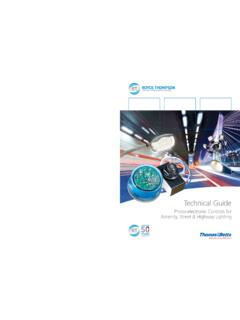Transcription of 2015 Hobart Airport Master Plan - Hobart International …
1 2015 Hobart Airport Master PlanThis Master Plan has been prepared by Hobart International Airport Pty Ltd (HIAPL) (ABN 27080 919 717).This Master Plan, and the assessments, forecasts, assumptions and strategies contained in this Master Plan, have been prepared as part of Hobart Airport s internal strategic planning processes and is in accordance with Part 5 of the Airports Act 1996, and should not be relied upon by any other person for any other all care has been taken in development of this Master Plan it is based on certain forecasts and assumptions and is subject to change. As a result the proposed development details are indicative only, there is no commitment that they will occur. Hobart International Airport Pty Ltd 2015 Hobart International Airport Master Plan | iForewordForewordWe are pleased to present Hobart Airport s 2015 Master Plan.
2 The 2015 Plan outlines and reflects Hobart Airport s vision for growth and the delivery of strategic infrastructure to meet demand and to better connect Tasmania with the rest of Australia and the world. In 2016 Hobart Airport will celebrate 60 years of operations. As the Hobart and Tasmanian community continue to grow, so will the demand for air transport for both passengers and freight. Since its privatisation in 1998 Hobart Airport has grown from 856,000 to million passengers per year. By 2020 we are expecting to welcome an additional half a million passengers per year and more than four and a half million per year by 2035. To be able to support the growth of the Tasmanian economy and meet the expectations of our passengers and partners, Hobart Airport will undertake two transformative projects over the next five year period.
3 These projects will significantly redefine the Airport and provide new economic opportunities for the State. The construction of a 500m runway extension will enable direct flights from Tasmania to South-East Asia for passenger and freight opportunities and allow for expansion of current Antarctic operations. The redevelopment of the Airport s passenger terminal will offer an improved experience for Airport visitors and cater for projected growth and enable International passenger processing. These projects will enable operation of direct flights to Asia for tourism, the export of time sensitive products (including key produce exports) and will enable increased logistic opportunities for Antarctic operations for both Australia and other Nations operating research programs in East Master Plan also provides plans for the continued development of the Airport s non-aviation activities, which underpin the long term economic viability of Hobart Airport and complement its key aviation role, and for the protection of areas of environmental significance on the Airport site.
4 In addition, the 2015 Master Plan addresses key matters facing the Airport including how it interacts with important road networks such as Tasman Highway and the need to be vigilant in ensuring the unhindered long term operation at Hobart Airport . Importantly, the plans provided in the 2015 Master Plan will allow Hobart Airport to build upon the foundations it has developed over the past 60 years and reinforce the role of the Airport as a critical piece of State infrastructure and an essential part of the Tasmanian community. Hobart Airport s vision for the next 20 years is to be Tasmania s premier Airport providing a boutique experience for our visitors and an economic hub that delivers opportunity and growth for the Tasmanian Community. With the support of our stakeholders and partners we will continue to grow and operate Hobart Airport in a responsible manner.
5 Every five years the Airport develops a Master Plan; this plan is the way we clearly communicate our plans with the community and key stakeholders. We value the opportunity to seek your feedback on our plans and welcome your Parry CEO Hobart Airport 2015 Hobart International Airport Master Plan | iiContentsContents1 Introduction ..1 Overview ..2 Vision for Hobart Airport .. Development Objectives ..4 History of Hobart Airport ..5 Hobart Airport Today ..6 Airlines and Tenants ..8 Developments since 2009 ..9 Previous Master Plans .. 102 Economic Benefit ..11 Introduction ..12 Hobart Airport s economic contribution ..12 Social Impacts ..14 Capital Investment ..153 National Policy and Regulatory Framework ..17 Introduction ..18 Airport Regulation 1997 ..23 Airport (Environment Protection) Regulations 1997.
6 24 Environment Protection and Biodiversity Conservation Act 1999 ..24 National Airports Safeguarding Framework ..25 State and Local Regulations ..26 State Coastal Policy 1996 ..28 Southern Tasmania Regional Land Use Strategy 2010-2035 ..28 Southern Tasmania Industrial Land Strategy 2013 ..29 Clarence Planning Scheme ..30 Sorrell Draft Interim Planning Scheme 2014 ..31 Recent Planning Decisions ..324 Land Use and Precinct Development ..33 Overview and Master Plan Precincts ..35 Runway Precinct ..38 Terminal Precinct ..38 Aviation Precincts ..40 Local Business Precinct ..41 Tourism/Mixed Use Precinct ..42 Environment Precinct ..43 Light Industrial Precinct ..435 Air Traffic Forecasts ..47 Introduction to Growth Forecasts ..48 Future Passenger Growth.
7 49 Forecasting for Design (Annual Busy Day and Busy Hour Demand) ..50 Busy Hour Forecasts ..51 International ..526 Passenger Terminal Planning ..53 Planning Approach ..54 Existing Situation ..54 2020 Terminal Design ..56 Planning Considerations ..58 Passenger Terminal Plan ..597 Airfield Development ..61 Introduction ..62 Existing Runway ..62 Existing Taxiway System ..64 Existing Aprons ..64 Passenger Aircraft Apron ..64 Freight and GA Apron ..65 Existing Freight Operation ..65 Existing GA Operation ..65 Proposed Runway Extension ..65 Introduction ..65 Runway Extension Description .67 Future Taxiway System ..68 Parallel Taxiway ..68 New Link Taxiways ..68 Future Aprons ..68 Passenger Aprons ..68 Multiple Use Aprons ..69 Freight Apron.
8 69 Future General Aviation Development ..69 Planning considerations ..69 2015 Hobart International Airport Master Plan | iii8 Landside Transport ..71 Introduction ..72 About the Ground Transport Plan ..72 Ground Transport Aims ..72 Objectives of the Ground Transport Plan ..73 Consultation ..73 Plans and Strategies Considered 73 Existing Ground Transport System ..74 Internal Roads ..75 External Roads ..75 Parking ..78 Public Transport ..78 Rental Car ..79 Active Transport Network ..79 Freight and Logistics ..80 Ground Transport Demand ..80 Existing transport demand by mode ..80 Current Daily Vehicle Demand .80 Future Daily Vehicle Demand ..80 Proposed Ground Transport External Roads ..82 Internal Roads ..82 Parking ..84 Taxi and Rentals.
9 84 Active Transport ..84 Public Transport ..849 Other Aviation Uses ..89 Air Services Australia ..90 Aviation Rescue and Fire Fight Services (ARFFS) ..91 Airport Operational Services ..92 Navigational and Land Aids ..92 Ground Based Augmentation System (GBAS) ..92 Airport Lighting ..92 Future Development ..92 Airside Signage ..93 Airline Support Facilities ..93 Airline Catering ..93 Aircraft Refuelling ..93 Ground Service Support ..9310 Utilities and Services Infrastructure ..95 Existing Services and Future Planning ..96 Future Development ..9711 Airspace Protection ..99 OLS and PANS-OPS ..100 Proposed changes to OLS and PANS-OPS ..10012 Aircraft Noise ..105 Introduction ..106 Background ..106 Noise Forecasting ..106 ANEF / ANEC.
10 107 Limitations of ANEF ..107 Preferred approach to planning decisions and noise exposure ..107 N70 / N60 108 Scenarios109 Noise Modelling Methodology ..109 Noise Modelling Results ..114 Ultimate ANEF ..114 ANECS and N60 / N70 ..114 Comparison between 2009 and 2015 ANEF ..114 Approach to managing aircraft noise intrusion ..11413 Environment ..119 Environmental Management ..120 Environment Strategy ..126 Resource Use ..126 Land ..127 Surface Water and Groundwater ..129 Biodiversity ..130 Cultural Heritage ..132 Air Quality ..133 Ground-Based noise ..134 Hazardous Materials ..13514 Consultation Program ..137 Informal Consultation ..139 Formal pre-release consultation ..139 Formal public comment period Submission to the Publication of Final Master Plan.


